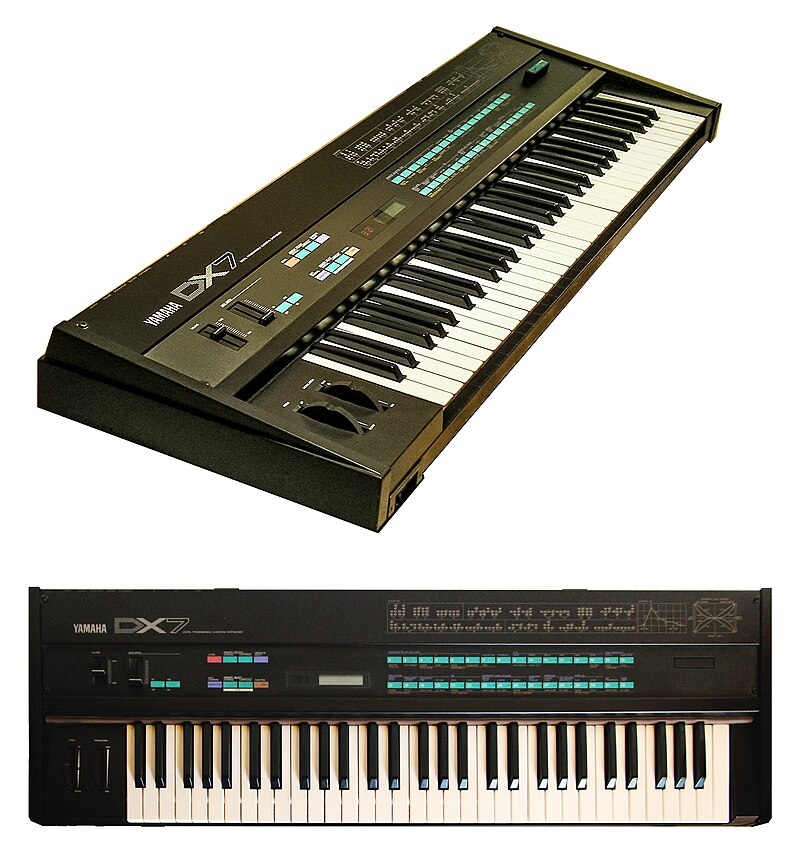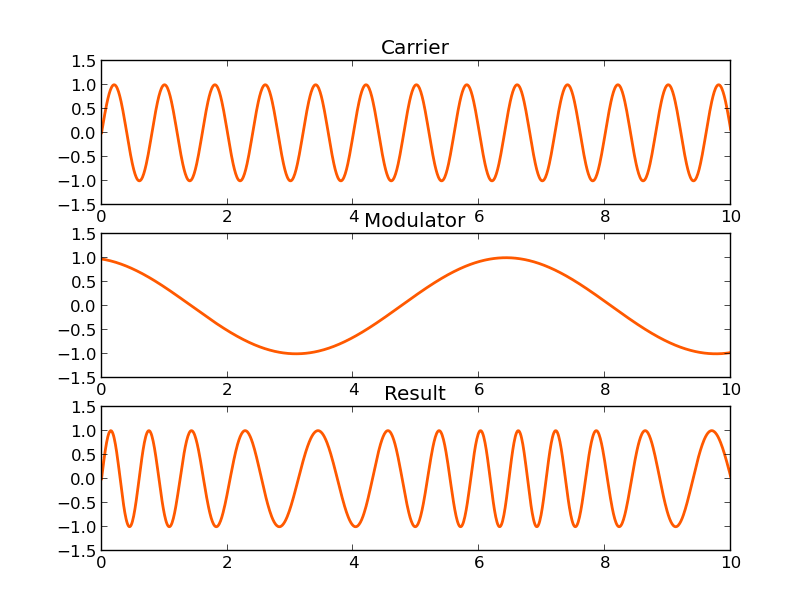Hey there, and welcome back to our journey into the incredible world of electronic sound creation! It’s time to explore the different flavors of synthesis, the unique ways these components (or entirely new concepts!) come together to make sound.
And for our first flavor, we’re diving into something truly distinctive: FM Synthesis.
When you think of classic 1980s electronic music, those glassy electric pianos, cutting bells, and sometimes wonderfully cheesy synth brass sounds, you’re often hearing the magic of FM synthesis at work. The most famous example? The iconic Yamaha DX7 synthesizer. It sounded unlike anything before it, and for good reason – it used FM synthesis, a completely different approach to making sound than the subtractive synths that dominated previously.
So, what exactly is FM synthesis, and why does it sound so… well, metallic and unique? Let’s unlock the mystery!

Forget Sculpting, Think Wiggling (Really Fast!)
Remember how in subtractive synthesis, we often start with a harmonically rich sound (like a sawtooth or square wave) and then subtract frequencies with a filter? FM synthesis is fundamentally different. We’re not starting with a ready-made complex sound and filtering it. Instead, we’re generating complex sounds by making one sound interfere with another in a very specific way.
Here’s the core idea: Frequency Modulation.
Imagine you have one simple sound, say, a clean sine wave (we call this the Carrier). You hear its pitch, nice and pure.
Now, imagine you use another sound (often another sine wave, called the Modulator) to constantly push and pull the pitch of that first sound (the Carrier).
If the Modulator wiggles the Carrier’s pitch slowly, you get vibrato – that pleasant wavering in pitch. Easy.
But here’s where FM gets interesting: What if the Modulator wiggles the Carrier’s pitch really, really fast? So fast that the wiggling itself becomes part of the sound’s timbre?
When the Modulator is at audio frequencies (meaning it’s wiggling at pitches we can hear), it doesn’t just create vibrato. It creates entirely new frequencies that weren’t there before! These new frequencies are called “sidebands,” and it’s the presence and strength of these sidebands that give FM synthesis its unique, harmonically complex, and often metallic character.
The Key Ingredients: Carriers, Modulators, and Algorithms
Okay, let’s break down the main controls you’ll see in an FM synth:
- Carriers and Modulators: As we discussed, the Carrier is the oscillator whose frequency is being modulated (that’s the sound you primarily hear). The Modulator is the oscillator that’s doing the modulating (you don’t usually hear the Modulator directly, only its effect on the Carrier).
- Modulation Index: This is super important! The Mod Index controls how much the Modulator affects the Carrier’s frequency.
- A low Mod Index means the Modulator is only wiggling the Carrier’s pitch a little bit. You get simple sounds, maybe close to a sine wave, or with just a few subtle sidebands.
- A high Mod Index means the Modulator is wiggling the Carrier’s pitch a lot. This creates tons of sidebands, resulting in very complex, noisy, or metallic sounds. Pushing the index high is often how you get those aggressive FM textures.
- Algorithms: This is where it gets a bit more visual. An algorithm shows how multiple Carriers and Modulators are connected. Do you have one Modulator affecting one Carrier? One Modulator affecting two Carriers? Do you have a Carrier feeding back into a Modulator? Different algorithms create vastly different potential timbres, even with the same basic oscillator settings. Think of the algorithm as the wiring diagram for your FM sound.

The Sound Palette of FM: Metallic, Glassy, and Punchy
Because of the way FM creates sound through frequency interaction, it naturally excels at certain types of timbres:
- Bells and Chimes: The rapid, complex harmonic changes are perfect for simulating struck metal sounds.
- Electric Pianos: Those famous DX7 sounds – sharp, bright, and often a bit percussive.
- Metallic Pads and Textures: Evolving sounds with a shimmering, sometimes abrasive quality.
- Sharp, Punchy Basses: FM can create basses with a very defined, almost digital edge that cuts through a mix.
- Percussive Sounds: From sharp clicks to synthetic drums.
- Sci-Fi and Robotic Effects: The unnatural, complex harmonics lend themselves well to futuristic sounds.
While you can try to make warm, organic sounds with FM, it’s often much easier to lean into its strengths: precise, complex, and often harmonically aggressive timbres.
Why Choose FM? (Strengths and Challenges)
Strengths:
- Unique Timbres: It creates sounds unlike anything else, especially those metallic and bell-like tones.
- Harmonic Complexity: You can get incredibly rich and complex sounds from just a few simple sine wave oscillators by modulating them.
- Efficiency (Sometimes): Early digital synths used FM because it was relatively efficient at generating complex timbres compared to needing lots of oscillators for additive synthesis.
- Expressive Potential: Modulating parameters like the Mod Index or Modulator pitch can lead to dramatic, dynamic changes in timbre.
Challenges:
- Less Intuitive: Compared to subtractive synthesis (which is more like adjusting familiar EQ controls), FM can feel less predictable. Small changes in parameters can lead to huge sonic shifts.
- Programming Can Be Complex: Understanding algorithms and the interplay of multiple operators takes practice and often a bit of trial and error.
- Can Sound “Digital” or “Cold”: While not inherently a bad thing, pure FM (especially from older digital synths) can lack the warmth and organic feel of analog subtractive synths.
Getting Started with FM
Ready to try it yourself? Most modern software synths have FM capabilities, or dedicated FM engines:
- Software: Native Instruments FM8, Arturia DX7 V (an emulation), Ableton’s Operator, Fl Studio Sytrus, even synths like Serum and Vital often have FM operators you can route.
- Hardware: The original Yamaha DX series, Elektron Digitone, Korg Opsix.
Simple Experiment:
- Find a synth that has at least two simple sine wave oscillators (often labeled Carrier and Modulator, or Operator 1 and Operator 2 with routing options).
- Set Oscillator 1 (your Carrier) to a sine wave. Make sure its output is audible.
- Set Oscillator 2 (your Modulator) to a sine wave. Turn its direct output off if possible (you only want to hear its effect).
- Find the routing or modulation control that lets Oscillator 2 modulate the frequency of Oscillator 1.
- Start with the Modulation Index (or similar control) at zero. You should just hear the clean sine wave from the Carrier.
- Slowly increase the Modulation Index. Listen as the sound goes from a pure tone, to a slightly richer tone, to a complex and possibly metallic sound, and maybe even into noise at high levels. Try changing the pitch of the Modulator oscillator as you do this – notice how it changes the harmonics drastically!
This simple experiment is the heart of FM. It’s all about that interaction and how intensely one sound wiggles the frequency of another.
Wrapping Up FM
FM synthesis is a powerful and distinct flavor of sound creation. It’s responsible for countless iconic sounds and offers a unique approach to generating complex harmonics from simple building blocks. While it can take a little getting used to compared to subtractive synthesis, the sonic rewards are well worth the exploration!
We’ve just scratched the surface of this fascinating method. In the next post, we’ll switch gears and explore a very different flavor: Wavetable Synthesis, where we’ll learn how to morph and evolve through entire collections of waveforms!
Have you experimented with FM synthesis? What are your favorite FM sounds? Let me know in the comments below!
